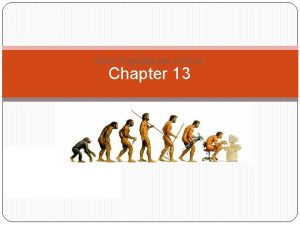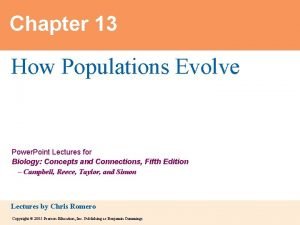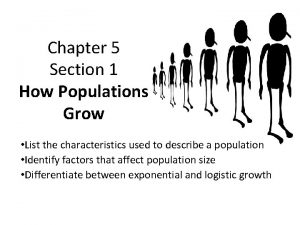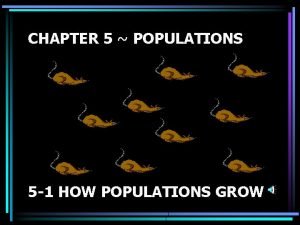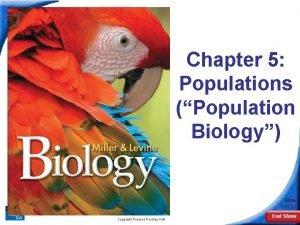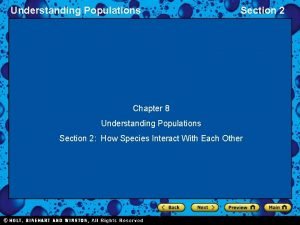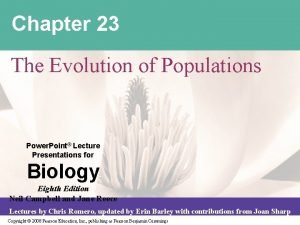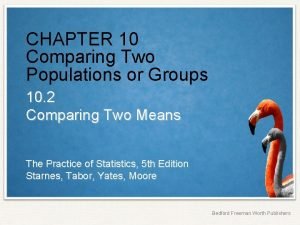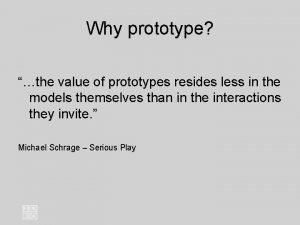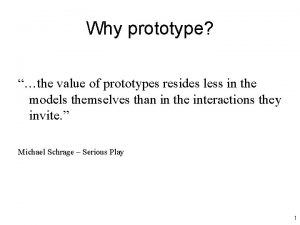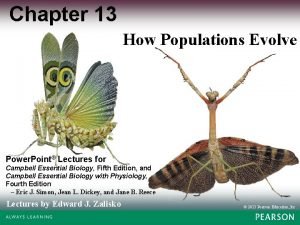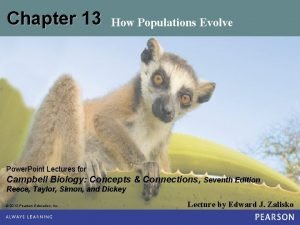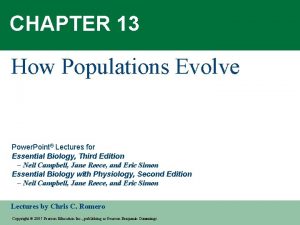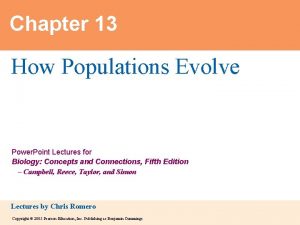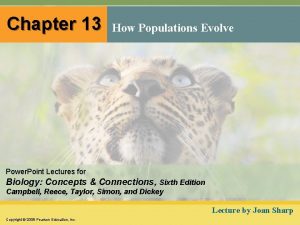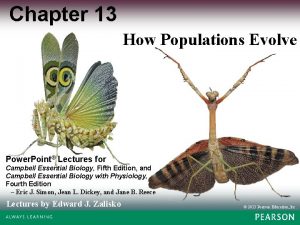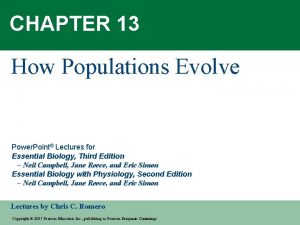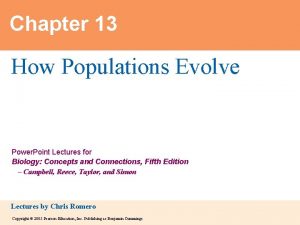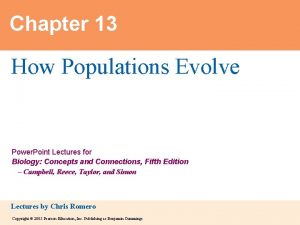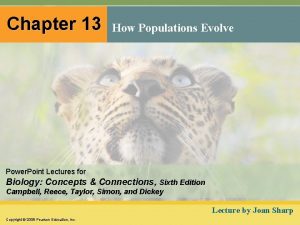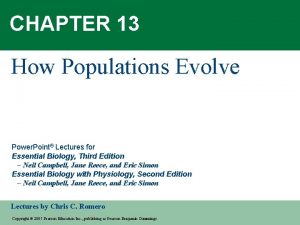Chapter 13 How Populations Evolve Power Point Lectures






















- Slides: 22

Chapter 13 How Populations Evolve Power. Point Lectures Campbell Biology: Concepts & Connections, Eighth Edition REECE • TAYLOR • SIMON • DICKEY • HOGAN © 2015 Pearson Education, Inc. Lecture by Edward J. Zalisko

© 2015 Pearson Education, Inc.

Introduction • In the 1960 s, the World Health Organization (WHO) launched a campaign to eradicate malaria. • They focused on killing the mosquitoes that carry the parasite from person to person by massive spraying of the pesticide DDT. • Early success was followed by rebounding mosquito populations that had evolved resistance to the pesticide DDT. • Today, malaria causes more than a million deaths and 250 million cases of illness each year. © 2015 Pearson Education, Inc.

Figure 13. 0 -2 Chapter 13: Big Ideas Darwin’s Theory of Evolution © 2015 Pearson Education, Inc. The Evolution of Populations Mechanisms of Microevolution

DARWIN’S THEORY OF EVOLUTION © 2015 Pearson Education, Inc.

Charles Darwin • English Naturalist • In 1859 he published “On the Origin of Species by Means of Natural Selection” • Convincing evidence that species evolve and a reasonable mechanism explaining how evolution occurs © 2015 Pearson Education, Inc.

Background on Darwin • Dad was a wealthy doctor • At age 16 Darwin was sent to Edinburgh, Scotland to study medicine – Repeatedly skipped lectures to collect biological specimens • 1827 was sent to Cambridge University to become a minister – He got his degree – More interested in natural science • 1831 (age 22) Darwin went on a voyage with the HMS Beagle as a naturalist © 2015 Pearson Education, Inc.

Figure 13. 1 a-0 HMS Beagle in port Darwin in 1840 North America Great Britain Europe Asia ATLANTIC OCEAN Africa Pinta Marchena Santiago Pinzón Fernandina Isabela 0 0 40 km Galápagos Islands Genovesa Equator Daphne Islands Santa Cruz Florenza 40 miles © 2015 Pearson Education, Inc. Santa Fe San Cristobal Española Equator South America PACIFIC OCEAN Andes PACIFIC OCEAN Australia Cape of Good Hope Cape Horn Tierra del Fuego Tasmania New Zealand

Figure 13. 1 a-4 HMS Beagle in port Charles Darwin © 2015 Pearson Education, Inc.

Scientists Before Darwin • Lucretius (2000 years ago)– Roman philosopher that 1 st proposed the idea that life evolves • Jean Baptiste Lamarck (1809) –Changes in species linked to “Physical Conditions of Life” – Believed that over the lifetime of an individual, physical features increase in size because of use or disuse • These changes then passed to offspring © 2015 Pearson Education, Inc.

© 2015 Pearson Education, Inc. Lamarck

Darwin’s Observations • Read Charles Lyell’s book “Principles of Geology” • Lyell proposed that the surface of the earth changed slowly over time • In South America Darwin found fossils of extinct armadillos • These fossilized animals closely resembled the armadillos living in the area present-day species are the descendants of ancient ancestors that they still resemble in some ways © 2015 Pearson Education, Inc.

13. 1 A sea voyage helped Darwin frame his theory of evolution • Adaptations • Diverse modifications (inherited characters) that enhance an organism’s ability to survive and reproduce in a particular environment 1. Inherited variations exist within genes of every population/species Result of random mutation and translation errors • An inherited trait that has become common in a population because the trait provides a selective advantage © 2015 Pearson Education, Inc.

© 2015 Pearson Education, Inc.

© 2015 Pearson Education, Inc.

13. 1 A sea voyage helped Darwin frame his theory of evolution • Consequently, scientists regard Darwin’s concept of evolution by means of natural selection as a theory 2. In a particular environment some individuals of a population or species are better suited to survive (variation) and have more offspring (Natural Selection) Those able to survive will reproduce © 2015 Pearson Education, Inc.

13. 1 A sea voyage helped Darwin frame his theory of evolution Evolution • the idea that living species are descendants of ancestral species that were different from presentday ones and that natural selection is the mechanism for evolutionary change 3. Over time, the traits that make certain individuals of a population able to survive and reproduce tend to spread in that population Favorable Traits © 2015 Pearson Education, Inc.

13. 2 The study of fossils provides strong evidence for evolution • Fossils • are the imprints or remains of organisms that lived in the past • document differences between past and present organisms • reveal that many species have become extinct 4. Overwhelming evidence from Fossils and many other sources that living species evolved from organisms that are extinct © 2015 Pearson Education, Inc. Ancestors

Figure 13. 2 a For example, the fossilized skull of one of our early relatives, Homo erectus, represents someone who lived 1. 5 million years ago in Africa. © 2015 Pearson Education, Inc.

13. 2 The study of fossils provides strong evidence for evolution • The fossil record is incomplete because • many of Earth’s organisms did not live in areas that favor fossilization • fossils that did form were in rocks later distorted or destroyed by geologic processes • not all fossils that have been preserved are accessible to paleontologists. © 2015 Pearson Education, Inc.

13. 3 SCIENTIFIC THINKING: Fossils of transitional forms support Darwin’s theory of evolution • Many fossils link early extinct species with species living today. • A series of fossils traces the gradual modification of jaws and teeth in the evolution of mammals from a reptilian ancestor. • A series of fossils documents the evolution of whales from a group of land mammals. © 2015 Pearson Education, Inc.

Figure 13. 3 b Pakicetus Rodhocetus Dorudon Living cetaceans © 2015 Pearson Education, Inc. Key Pelvis Femur Tibia Foot
 Chapter 13 how populations evolve test
Chapter 13 how populations evolve test Chapter 13 how populations evolve
Chapter 13 how populations evolve Gene pool
Gene pool Power system lectures
Power system lectures Power trianlge
Power trianlge Power bi training powerpoint
Power bi training powerpoint Point point power
Point point power Chapter 16 evolution of populations vocabulary review
Chapter 16 evolution of populations vocabulary review Chapter 17 evolution of populations answer key
Chapter 17 evolution of populations answer key Chapter 5 lesson 1 how populations grow answer key
Chapter 5 lesson 1 how populations grow answer key Chapter 5 lesson 1 how populations grow
Chapter 5 lesson 1 how populations grow Chapter 23: the evolution of populations
Chapter 23: the evolution of populations Section 16-1 genes and variation
Section 16-1 genes and variation Chapter 10 comparing two populations or groups answer key
Chapter 10 comparing two populations or groups answer key Chapter 5 lesson 1 how populations grow
Chapter 5 lesson 1 how populations grow Chapter 8 understanding populations
Chapter 8 understanding populations Chapter 23 the evolution of populations
Chapter 23 the evolution of populations Chapter 21 vulnerability and vulnerable populations
Chapter 21 vulnerability and vulnerable populations Chapter 10 comparing two populations or groups
Chapter 10 comparing two populations or groups Explore evolve validate prototype
Explore evolve validate prototype City and guilds secure assess
City and guilds secure assess City and guilds evolve secure access login
City and guilds evolve secure access login Explore evolve validate prototype
Explore evolve validate prototype
